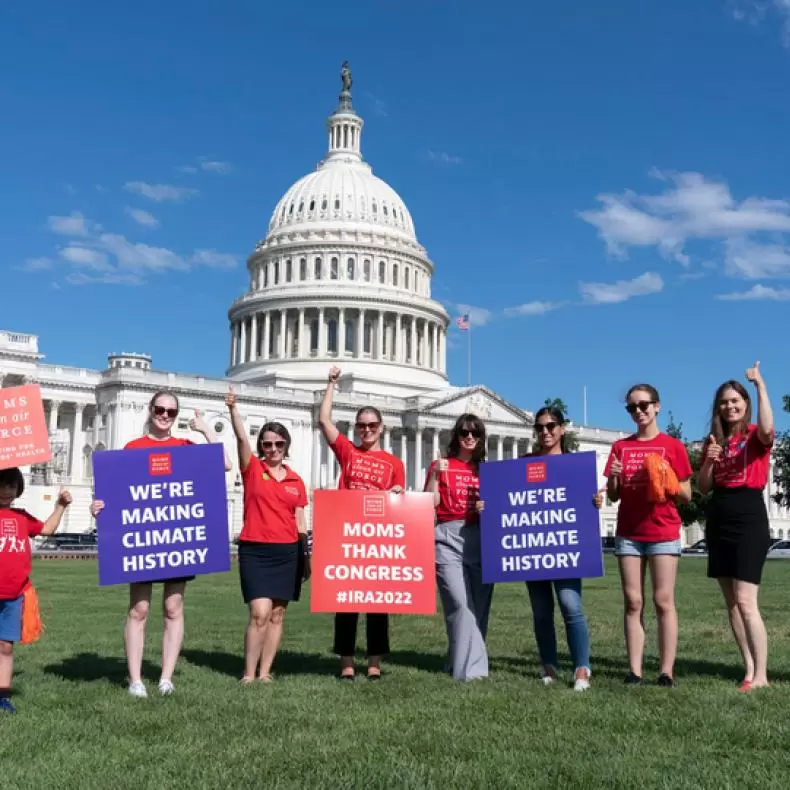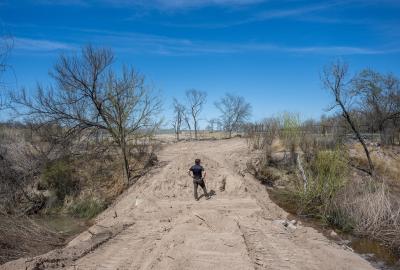The Inflation Reduction Act is a victory for the climate. Here's what comes next
On August 16, President Biden signed the biggest package of climate investments in U.S. history into law.
The Inflation Reduction Act includes $369 billion in funding to tackle climate change and brings America closer to Biden’s goal of cutting climate pollution in half from 2005 levels by 2030.

A year ago, the political affairs team at Environmental Defense Fund made getting this bill passed their top priority.
"Work on this bill is best described as a year-long roller coaster," says Elizabeth Gore, EDF’s senior vice president of political affairs. “It is amazing that when we got to the end of the legislative process we had such a transformational and ambitious bill."
In the end, Gore says it was a combination of preparation and persistence that pushed the bill across the finish line. “EDF staff and others across the environmental community and across Capitol Hill worked on various provisions for months and months,” Gore says. “So when the window of opportunity opened, the legislative language was ready to go and the hard negotiations had already happened.”
Now the law needs to deliver results on the ground. Here are a few key efforts:
A boost for clean trucks
Transportation is the biggest source of U.S. climate pollution, which makes the Inflation Reduction Act’s investment in clean vehicles a huge step forward.
Along with tax credits, the legislation allocates billions toward transportation electrification, including $3 billion for the U.S. Postal Service to electrify its fleet of more than 200,000 vehicles, $3 billion to reduce pollution at ports and $1 billion toward clean school and transit buses, garbage trucks and other heavy-duty vehicles.
Electrifying trucks is a key way to fight climate change because even though trucks and buses only make up about 10% of vehicles on U.S. roads, they are responsible for 30% of the climate-disrupting emissions.
So far, nearly 200 U.S. fleets have deployed or committed to deploy zero-emission trucks, including industry leaders like FedEx and PepsiCo, but upfront costs are still prohibitive for many others.
“The costs are still coming down on this technology,” says Jason Mathers, who leads EDF’s zero-emission trucks initiative, which works with manufacturers, fleet owners, investors and policymakers to get dirty trucks off the road. “So it’s really important to have federal investment to help ramp up the market.” The Inflation Reduction Act, which EDF worked to ensure would cover medium- and heavy-duty trucks as well as light-duty vehicles, provides that investment boost.
To further support fleet owners transitioning to zero-emission vehicles, EDF also launched ElectricFleet.org, an online guide of best practices when converting to EVs for fleets large and small.
“We have gone from zero-emission trucks being sold in ones and twos to having orders of thousands today,” Mathers says, adding that he’d like the EPA to recognize this momentum and set stricter pollution standards. “But the pace of improvement that we’ve already seen, coupled with this new federal investment, gives me a lot of hope that we are on our way to transitioning all U.S. trucks and buses to zero emissions.”
Regulators take aim at planet-warming methane
From 2012 to 2018, EDF-led research revealed a startling miscalculation: Methane pollution from the oil and gas industry was 60% higher than previously estimated. Given that more than 25% of today’s global warming is driven by methane, including emissions from the oil and gas sector, this was a big deal.
“Most of the focus had been on carbon dioxide,” says EDF climate scientist Tianyi Sun. “But methane has more than 80 times the warming power of carbon dioxide during the first 20 years it’s in the atmosphere.”
So EDF began a crusade to help both the public and policymakers understand this other, potent greenhouse gas. Over the past decade that has meant meetings with leaders, TED talks by EDF experts, and eventually several victories, including critical new EPA rules to cut oil and gas methane pollution.
Now, methane is getting its moment once again — in the Inflation Reduction Act — which creates a program to tackle methane pollution. Administered by the EPA, the Methane Emission Reduction Program charges oil and gas operators for wasteful emissions. The fee starts at $900 per metric ton in 2024, giving companies a big incentive to reduce methane pollution.
EDF’s work to track and measure methane pollution will help the new rules have teeth. And EDF subsidiary MethaneSAT will soon launch a first-of-its-kind satellite that will provide free data for regulators and companies to track pollution.
A funding frenzy
Both the Inflation Reduction Act and the 2021 infrastructure bill will pump billions of federal dollars into environmental efforts across the U.S. from rural communities to coastal cities, and prioritizing environmental justice. How and where that money gets spent is critical, says Steve Cochran, who leads EDF’s new state affairs department, which was created last year.
“Our federal and state staff will work together to make the system work, because the reality is that the federal government is not set up to address nuance state by state,” he explains.
Cochran has been hiring directors across 13 states who will act as conduits to bring in EDF’s expertise on climate-related issues in consultation with local communities. “EDF is a multifaceted, highly knowledgeable organization, so our state directors will tap into that expertise and bring the assets of EDF to bear in their states,” Cochran explains.
For example, in Cochran’s home state of Louisiana, hundreds of thousands of oil and gas wells have been drilled, a number of which are abandoned and need to be plugged and cleaned up.
“These abandoned wells are basically methane leaks that need to be fixed, and EDF has really good people in the business of doing that,” he says. “It’s a perfect match: EDF’s expertise, the states’ needs, and the new federal funding," Cochran says. "Now we just have to get it done."


